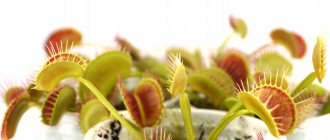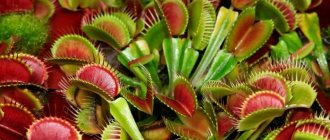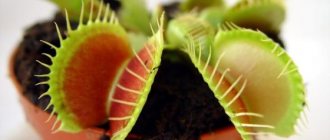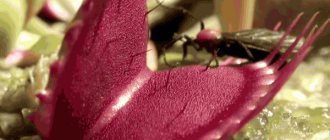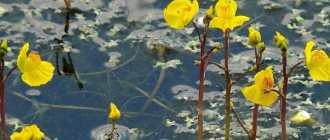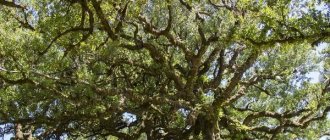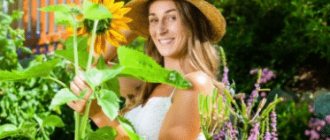Dionaea muscipula is a rare and protected plant of the Sundew family that uses insects for food. Better known as the Venus flytrap. Scientists explain the Latin name (mousetrap) as an error in the description of the species.
Exotic is characterized by an original appearance, unnatural behavior for plants and an unusual way of feeding. The hunt of a predator is a fascinating sight. This process will not leave anyone indifferent.
The height of an adult dionaea is 10–15 centimeters. On a short bulbous stem there is a rosette of four to seven leaves. In May–June you can see the peduncle. At its top, an inflorescence of a corymb is formed, consisting of white flowers (their diameter is about a centimeter), emitting a sweet, pleasant aroma. Flowering lasts one to two months.
When Dionaea fades, traps grow on the tops of the petioles (they stretch 8–15 centimeters in length). They are formed by two green doors that can slam shut. In bright light, the inner walls become reddish in color. The edges of the valves are covered with bristles and have triggers. When triggers become irritated, the trap slams shut. The cavity contains glands whose function is the synthesis of nectar, which serves as bait for insects. When the victim falls into the trap, digestive secretions begin to be synthesized. The food is digested for one to two weeks, after which the valves open and await the next victim. Once the trap has eaten two or three insects, it will die off in most cases. But some traps manage to digest even 7 victims.
In nature, the predator's home is peat bogs located in the southern part of North America. To compensate for the lack of nitrogen, it catches slugs and hunts for insects.
The Venus flytrap is one of the most popular indoor plants. It is grown by flower growers all over the world.
The genus Dionaea is monotypic - contains only one species (Venus flytrap). But breeders have created many varieties.
5% discount with promo code SR5!
Especially for our blog readers.
Description
The Venus flytrap is a small herbaceous plant. The leaf blades of a representative of the Sundew family grow from a short underground stem. The length of the foliage reaches 3–7 cm. The upper part of the trap is painted with pigments that give it a reddish tint that attracts insects. The flowers, located at the tips of the stems, are quite small. Their outlines resemble the shape of a star. The average lifespan of a plant is 6–7 years. Looking through the photo, gardeners pay attention to how unusual the plant looks.
General information
The Venus flytrap (Dionaea muscipula) belongs to the Sundew family. In nature, it is found on the east coast of America, in swampy lowlands. It was the lack of minerals in swampy soils that led the flycatcher to develop a “specific” method of extracting them - the bodies of the insects it “processes” contain the nitrogen necessary for the life of any plant. Surprisingly, Dionaea muscipula received its Russian name in honor of the Roman goddess of love.
The flytrap plant is a small herbaceous rosette of several compact (3 to 7 cm) leaves growing on a short bulbous stem. Dionaea flowers are white, simple, on long stems. After flowering, trap leaves grow. The Venus flytrap is actively cultivated in indoor floriculture, although growing and caring for it is difficult due to the low air humidity in apartments.
Caring for a Venus flytrap at home
Caring for a Venus flytrap at home is not difficult. The most important thing is to provide the plant with the correct conditions, namely: timely watering and replanting, acceptable temperature, and humidity level.
Location and lighting
Flower growers recommend placing containers with dionaea on window sills located on the west or east side of the house. The plant needs fresh air, so it is important to systematically ventilate the room. In the warm season, you can take flowers out into the garden.
Flower content temperature
In summer, the temperature in the room where flowers are grown should be within +25...+35 °C. In the cold season, you can reduce the temperature to +5...+7 °C. The Venus flytrap (Dionea) needs a period of rest.
Watering
The plant can only be watered with rain or distilled water at room temperature. It is unacceptable to use tap water to moisten the soil. The soil for the Venus flytrap should always remain slightly moist. On hot days, it is recommended to systematically spray the insectivorous crop.
Soil and pot
To prepare the soil substrate, you will need to mix peat with quartz sand and perlite (2:1 ratio). The sand is first doused with boiling water, and the perlite is kept in water for 5–7 days (the water needs to be changed daily). The Venus flytrap flower is not planted in nutritious soil so that the plant does not get sick.
The container for planting dionaea must be deep, because the root system penetrates 20 cm deep. The diameter of the pot can reach 10–12 cm. It is worth purchasing containers of a light shade, since dark colors attract sunlight, which causes overheating of the roots.
Planting and replanting Dionaea
It is advisable to carry out planting work in the first weeks of March, when active growth is just beginning. Depending on the size of the plant, you need to select the size of the pot. Dionaea is placed in a container filled with peat and sand. The soil mixture is moistened abundantly. The pot is moved to a well-lit place.
Venus flytraps are replanted annually. The main goal is soil renewal. Over time, the soil deoxidizes, so it is important to regularly replace the old soil mixture with a fresh substrate with the required acidity level.
Venus flytrap blooming
The flowering period of the Venus flytrap begins in May-June. Small flowers, painted white, form at the tops of the shoots. If it is important to achieve maximum development of traps, it is worth removing shoots with flowers. In addition, such actions can stimulate the appearance of daughter rosettes.
Fertilizers and fertilizers
The Venus flytrap is a carnivorous plant that can absorb essential elements from its prey. The flower does not need any other fertilizing.
During periods of active growth, a few small flies/mosquitoes/spiders will be enough for the crop. If Dionaea grows in the garden, it will attract prey on its own. For flowers that are grown indoors, you will need to first catch insects and launch them towards the predator.
Winter dormancy period
The plant annually needs a period of rest, the duration of which reaches 2–5 months. If the dormant period lasted less than 8 weeks, growth activity will be reduced.
Feeding
When purchasing Dionaea, be prepared for the fact that it will have to be regularly fed with insects. When kept at home, she has no one to attract with her fragrant death traps. Please note that the following are absolutely not suitable for feeding:
- Beetles with a hard chitinous cover.
- Earthworms.
- Small rodents and chicks.
- Food from your table, such as sausage, meat, any crumbs.
The plant is not able to digest them, and rotting remains can easily cause the death of the traps or even the death of the entire plant.
The Venus flytrap is fed small spiders, flies and mosquitoes. The frequency of feeding is 2-3 weeks, depending on the age and appetite of the plant. The optimal size of the prey should be ½ the size of the trap, otherwise the Dionaea will not be able to digest or hold it.
Remember that the insect must be alive!
When feeding, you need to place food in different traps each time. Feeding takes a lot of effort and time, the plant may not have time to restore them. After opening the trap, you need to carefully inspect it and remove any remaining undigested food.
It is best to grow Dionaea in a small aquarium. Then you can introduce insects to it and cover it with a lid for a while so that the predator has lunch on its own.
Do not feed Dionaea from September to March, during the dormant period, so that it does not waste energy. Also, you should not offer to hunt newly transplanted, sick or weakened plants. Dionea, digesting its prey, receives nitrogen from it, which does not bring anything good to any plants during hibernation.
Wintering
Carnivorous plants are purely summer “inhabitants”. In cold weather they go into a kind of hibernation.
During this period, they do not require complementary feeding or light. Watering is also reduced.
What is important is the strong drop in temperatures. From October to March, dionea needs cold - 7-10 degrees Celsius. You can take it out to a closed loggia, put it in an empty place in the refrigerator, or, if you live in a private house, place it on the veranda.
During wintering, Dionaea will turn black - this does not mean that it has died.
In March, move it back into the house, add a little watering and wait.
In a month or two, the flycatcher will wake up and new shoots will appear. You can cut off the old ones.
Photo 4. Blackened Dionaea traps
Reproduction of Venus flytrap
There are many ways to propagate this insectivorous crop. Below you can find out more about each of them.
Cuttings
For propagation, take a cutting without a trap. After that:
- The container is filled with a mixture of peat and perlite.
- The cuttings are planted at an angle.
- Peat is moistened abundantly.
- The pot is transferred to a well-lit greenhouse where the humidity level reaches 90%.
The appearance of sprouts is expected within 3–4 weeks.
Department of baby bulbs
Every 3 years, during transplantation, the daughter bulbs can be separated from the dionaea. It is not recommended to separate a large number of children so that the culture does not weaken.
Seeds
To grow a Venus flytrap from seeds, you will need to purchase planting material from a specialized store. Seeds are planted in a greenhouse. The beds are first covered with a layer of substrate, which consists of 70% sphagnum moss and 30% sand.
Step-by-step landing algorithm:
- 10 minutes before planting, the seeds are treated with a solution of the Topaz preparation.
- The seeds are placed in the substrate. Sprinkling with soil is not necessary.
- Using a spray bottle, moisten the soil abundantly.
- The bed is covered with a film, which can be removed only after the seedlings have formed 2 leaf plates. Until this time, the film is removed daily for 10 minutes for ventilation.
Peduncle
Peduncles take away strength from the plant, so it is recommended to periodically cut them off. This must be done while he is still small. The peduncle is used as a cutting, rooted and a Venus flytrap is grown from it at home.
Planting and transplanting
The Venus flytrap is transplanted as the previous pot becomes too small for it. It is most convenient to do this in the spring at the end of the dormant period.
It is recommended to transplant newly purchased Dionaea from the shipping container after quarantine. Its duration is 1-2 weeks.
Replanting will also be required if the soil has become too dense, covered with plaque, and pests have infested it.
Pot
The best option for a Venus flytrap is to grow it in a florarium or an aquarium.
If the owner chooses a regular pot, a tall but narrow container should be preferred. Approximate dimensions 20 cm in height and 10 cm in diameter.
It is preferable to use pots of light colors, because Dionaea roots are afraid of overheating. The container should have a large number of drainage holes.
Only plastic pots are allowed. Plants that require acidic soil are not planted in clay containers.
Priming
The Venus flytrap is accustomed to poor soils. A substrate with a large amount of minerals is detrimental to it. Optimal acidity is 3.5-4.5 pH.
The simplest soil composition for a Venus flytrap is a mixture of high-moor peat and coarse river sand, taken in equal proportions.
Boil the sand in distilled water before mixing with peat.
An alternative soil recipe for dionaea includes 3 components:
- 4 parts peat:
- 2 parts perlite;
- 1 part sand.
Before preparing the substrate, perlite is soaked in distilled water for a week. During this time, the water needs to be changed twice.
Diseases
Against the backdrop of an excessively high level of humidity, sooty fungus and gray rot can form on perennial bushes. You can rid the plant of them by treating them with a fungicidal agent (Topaz and Chorus). By following the recommendations for caring for Venus flytraps at home, you can prevent the development of these diseases.
Dionaea also often suffers from bactericidal damage, which develops in cases where the culture cannot digest the caught prey. If this happens, you need to cut off the problematic trap and spray the Venus flytrap with a fungicide.
What can threaten the flycatcher: diseases and pests
The flycatcher is a fairly viable plant, but if the conditions of maintenance are significantly violated, it can be susceptible to certain ailments:
Gray rot.
Gray rot affects Dionea during systematic overflow. This is especially true if the temperature in the room where the flycatcher lives is low. Gray rot resembles fluff - it can appear on any part of the plant. The disease must be combated by adjusting the conditions under which the Venus flytrap is kept and using fungicides.
Bactericidal defeat
The most dangerous disease of the flytrap, as it quickly spreads through healthy tissues and, if measures are not taken in time, Dionea may die. Bactericidal damage appears when a predator plant has caught prey that is “too tough” and cannot completely digest it. As a result, the trap turns black and rots. Rot quickly spreads to neighboring organs, so it is important to remove the affected parts as quickly as possible with a sterile instrument and treat Dionea with a fungicide.
Insect infestation
A little strange, but an insectivorous plant itself can be attacked by insects. This happens quite rarely, but it is still better to be aware of the possible danger.
Dionaea traps are susceptible to aphid attacks. If this happens, they become deformed. Like any other plant affected by aphids, the Venus flytrap must be treated with insecticides, preferably in aerosol form.
Another pest that can attack a predator plant is the spider mite. This usually happens when the indoor air is too dry to support a flytrap. Treatment with acaricides will help.
Other problems
When using hard water to water Dionea, the soil gradually becomes salinized with minerals, especially calcium. Dionaea will react to excess minerals by yellowing the leaves.
With insufficient watering and systematic drying of the top layer of soil, the Venus flytrap can shed all its leaves. To prevent this from happening, always keep the soil in the pot slightly moist.
The flycatcher loves the sun, but the rays passing through the glass can be too hot and cause burns on the plant. Carefully observe the young shoots and, if the sun turns out to be too aggressive, shade Dionea.
Pests
The insectivorous plant often suffers from an invasion of pests, as a result of which its trapping apparatus is deformed. Quite often aphids appear in traps. To cope with aphids, it is recommended to treat the perennial with an insecticidal agent.
Growing Dionaea is very exciting. Caring for a Venus flytrap is not difficult, so even a novice gardener can handle it. But in order for the plant to be healthy, it is important to create suitable conditions for it. By providing the crop with proper care, you can grow a healthy flower, the growth of which will be interesting for all family members to watch.
Diseases
All dionaea diseases appear from improper care. It is important to notice every problem in time in order to save the flower. Otherwise, after a month of late efforts, the completely dead plant will have to be thrown out.
The most common disease of the Venus flytrap is rot in any of its manifestations. Leaves may turn black or yellow, and traps may rot - the reason for this is usually water. Rotting of the plant can begin due to excess moisture or prolonged watering with plain water.
In the case of excessive moisture in the soil, it is worth removing all moss from the surface, because it contributes to additional moisture, and not watering at all for some time.
If you ignore the advice about watering carnivorous plants with distilled water, and use running water as such, you will not be able to cure the plant - it has absorbed enough minerals and there is no longer any way to remove them “from the body.”
Blackening can also occur for other reasons. For example, a trap “caught” an insect that was too large for its size and was unable to completely digest it. This can cause the trap to warp and begin to rot. It must be cut and treated with a fungicide - a weak solution of potassium permanganate.
Also, “inedible” insects – aphids – may appear inside the foliage. To get rid of pests, treat the entire plant with an insecticidal preparation (it will be more convenient to do this in the form of spraying, i.e. using an aerosol).
Types and varieties
The Venus flytrap is the only representative of its genus. However, there are many varieties of Dionaea. They differ in color, size and number of traps.
- Dantate Trap. The diameter of the plant reaches 12 cm. The number of traps varies from 5 to 12. The flowers are green in color with a red stripe on the outside.
- Giant. The variety is distinguished by large, quickly forming traps measuring more than 5 cm. The rosette of leaves is green in color, and the traps are deep burgundy in the light.
- Akai Riu. The leaves and flowers of this Dionaea have a dark red color, regardless of the degree of illumination of the plant. The traps have a green stripe on the outside.
- Regyula. Plants of this variety have green and purple colored traps. The leaves have a rich green color.
- Bohemian Garnet is distinguished by a lush rosette with wide leaves growing horizontally. The number of traps can reach 12.
- Funnel Trap. Dionaea changes the color of its traps from green to red as it matures.
- Crokedile. In young plants the traps are pale pink, in adults they are deep red. Leaves grow horizontally.
- Triton. This Dionaea is distinguished by unusual elongated traps, with an opening on only one side. The teeth of the traps often stick together.
- Dracula. In this variety, the traps are painted red only on the inside. The teeth of the traps are short, reminiscent in shape of the jaws of vampires, which is why the variety got its name.
Interesting fact
Unlike most plants that require fertilizers during the active phase of growth and development, Dionaea has a root system that is not capable of receiving mineral nutrients from the soil. She has the ability to synthesize them herself. The only substance it needs and cannot produce is nitrogen. Its source is insects caught in traps. Without regular feeding by mosquitoes, flies and spiders, the plant stops developing, begins to starve and soon dies.
Folk signs
Venus flytraps are not only owned by lovers of exotic plants. It attracts flower growers not only with its unique life processes, but also with the numerous folk signs and beliefs that this charming predator has acquired.
It is believed that Dionea is able to “catch” a groom for an unmarried girl. To do this, you should invite him home, for example, to admire exotic plants. After he has been in the room with the Venus flytrap, he will never be able to part with his bride again.
It is also believed that the Venus flytrap can calculate and scare away people with bad intentions. Some individual entrepreneurs and businessmen start dionaea in the office to recognize whether they have a reliable partner or a dishonest fraudster.
Of course, you shouldn't take these beliefs at face value. However, they arose largely due to the rarity and exoticism of the plant and at least indicate that it is worth keeping a Venus flytrap, if only to satisfy curiosity and gain valuable experience in plant growing.
Accommodation in an apartment
In an apartment, it is best to place Dionaea on a south-eastern window sill, where it will receive the necessary lighting without direct sunlight. However, the main problem is humidity, since it is very difficult to achieve moisture on a window.
It is recommended to keep Dionaea on the windowsill, but in a tall glass container . It should be open for ventilation, but at the bottom have a layer of wet moss or expanded clay. In such conditions, Dionaea does not lack moisture and grows well.
